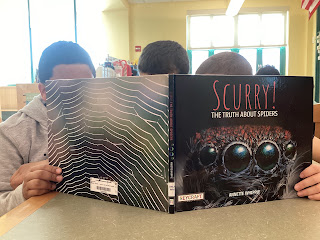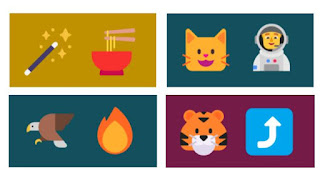2022 Animal Sibert Smackdown
While I have done many Mock Caldecotts over the years, I had never done a Sibert Smackdown. This seemed to be the perfect year to introduce this as I focus my time and energy on nonfiction. As I write this 4 months into the school year, over 50% of read alouds are nonfiction (I am auditing this), and I am about 85% of the way through reorganizing the nonfiction section for easier browsing. Melissa Stewart's article about nonfiction's image problem resonated with me and inspired me to focus my school year on nonfiction and how I put it in the hands of my students.
 |
| A group examines their book in preparation to assess it |
Reading and thinking about the contenders
I chose the theme of “animals” to tie things together (although the “ducks” aren’t exactly alive…) I wanted to look at different kinds of nonfiction books (without getting too into the weeds) and chose these books for our Smackdown:
 |
| 2023 Sibert Smackdown contestants |
I created a series of four questions for students to reflect on to assess the quality of the books we read for this unit. Grades 1-3 answered these informally on the rug via a show of thumbs.
 |
| Students assessed each book according to these four criteria |
4th and 5th grade students answered the same questions on paper as we read. I modified Melissa Stewart's rubric for our initial rating of the books.
 |
| 4th and 5th graders assessed the books on paper |
 |
| Images like these got students' attention and kept them captivated throughout the book. |
Next, we "read" Animal Toolkit without reading a single word of the text. I chose several pages and we looked at the illustrations and read the captions. This page in particular got students' attention. Lots of "ews" as we discovered just how apes and monkeys floss.
 |
| The "gross" factor kept students' attention. Flossing with hair or fur? Yuck! |
In our next class, we dove into a series of beautiful nonfiction books by Annette Whipple. Students examined these in small groups. They all had the same format which enabled us to have conversations about the structure, while reading different content.
 |
| Having a small group experience allowed students to read the book at their own pace. |
I used this opportunity to dive into backmatter. I explained that some authors like to leave us extra tools that may help us understand what we read, or help us know more about the subject. In their groups, students were instructed to find backmatter.
 |
| Backmatter found - glossary, suggested websites, DIY instructions |
 |
| Backmatter found - information about the author and her picture with the animal the book was about |
 |
| We learned that some ducks "swam" for YEARS! |
The vote
 |
| 1st and 2nd graders chose a book and explained why. |
 |
| 4th and 5th graders chose their top two books and completed a side by side comparison. |
 |
| 4th and 5th grade students then explained their choice, something they learned, and who they would recommend the book to. |
Results
 |
| Students felt very strongly about the top two contenders. |
Wrap up
On our final day, I shared the results and had students create either an animal crossing (most popular choice) or a container for an animal. Students could build with magna tiles, legos, plus plus, or planks.
 |
| Student made (magnetic) animal crossings |
Reflections
A major contributing factor to the success of this unit was honestly in book choice and delivery.
Narrative nonfiction (I read these aloud to classes)
Ducks Overboard by Markus Motum
Crossings by Katy Duffield
Traditional (table groups each had a book to read as a group)
Annette Whipple books
Expository (We looked at several pages and the images and captions - we never read any of the text
The Animal Toolkit by Steve Jenkins
I ended up changing the wording on the fourth assessment question. I initially used "ease of use" as the fourth category, but the books I chose did not have a table of contents or an index (they weren't needed). I didn't want this to influence student votes and have them mark a book down because it didn't have something it didn't need. I ended up focusing on backmatter which was present in all books. I used this opportunity to discuss what it was and had them find examples of it. I described "backmatter" as the extra "stuff" authors leave us because they know we are curious and they only had so much room for what they want to say. Here they share a little extra and point us to more help.
The most powerful part of the experience was at the end where 4th and 5th grade students had to identify their top two candidates and do a side-by-side comparison. My challenge for the next Sibert Smackdown will be how I replicate this for the younger grades.
Overall, I would call this a success.
- Students love reading nonfiction
- We had a shared experience across the school
- The books we read are in constant circulation
Resources
Sibert assessment questions (thumb assessment)
Sibert assessment questions (written)
Soapbox: Children's Nonfiction Has an Image Problem by Melissa Stewart
5 Kinds of Nonfiction: An Update by Melissa Stewart




Comments
Post a Comment